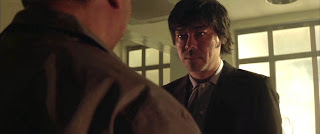Section A
A jump cut
A jump cut explains an immediate transition from one scene to another. For example a jump cut in film editing, changes two sequential shots of the same topic, there taken from the same topic and then the camera positions will only vary slightly. This type of edit develops the subject of the shot to appear to "jump" position in a discontinuous way. Therefore, jump cuts are considered a infringement of classical continuity editing in which aims to produce the appearance of continuous.
A point of view shot
A Point of view shot resembles the camera showing the character position of what they see. Its an example of what creatures would see. It describes the camera placement at the approximate position of the character.
Cutaway
In films a cutaway signifies an interruption of a continuously filmed action. They do this by inserting a view of something else. It is usually, although not always, followed by a cutback to the first shot.Cutaway are used in ways such as:
Cutaways do not have to be displayed on their own they do not have to contribute any dramatic content of their own. They are often being used to help the editor assemble a longer sequence. Therefore,editors choose cutaways related to main action such as another action or object in the same location. For example, if the main shot is of a man walking down an alley, possible cutaways may involve a shot of a cat on a bin or a shot of someone watching nearby.
Cutaways are mainly used to adjust the pace of the action.For example if some of the main shot is not wanted or they want to merge two of the same shots together.
Over the shoulder shot
Over the shoulder shots are used in films to display a shot of someone or somthing taken over the shoulder of another person. The back of the shoulder and head of this person is used to frame the image of whatever (or whomever) the camera is pointing towards. This type of shot is very common when two characters are having a discussion and will usually followan establishing shot which helps the audience place the characters in their setting. Its an example of a camera angle.
Section B
Point of view shot |
| Point of view shot |
 |
| Over the shoulder shot |
 |
| Over the shoulder shot |
 |
| Jumpcut |
websites used
http://www.googleimages.co.uk/
http://home.adm.unige.ch/~madsen/Film_Glossary.htm


No comments:
Post a Comment